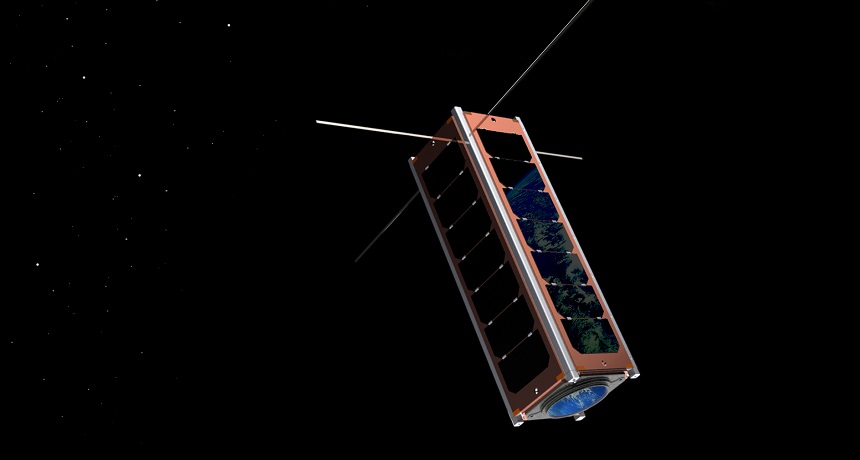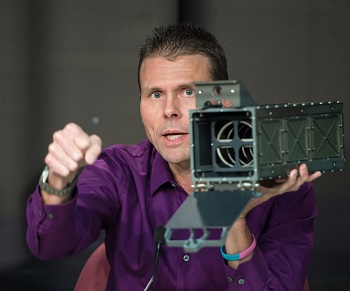Mini-sats: The trick to spying Earth-bound asteroids?
Five satellites, each just a few centimeters (inches) on a side, could find asteroids that pose a threat to Earth

This illustration shows what a CubeSat would look like in space. Used for many low-cost projects in recent years, these mini satellites might one day scout for killer asteroids.
Clyde Space
Go tiny or go home. That’s one suggestion for building telescopes to find a city-smashing asteroid before it finds us. Asteroids are space rocks, which can range from boulder sized up to chunks of rock nearly 1,000 kilometers (621 miles across). Most of them orbit between Mars and Jupiter. A fleet of pint-sized satellites orbiting the sun could track down the majority of asteroids that threaten Earth’s safety. Or that’s what a team of scientists now proposes.
Others aren’t so sure. This plan has holes big enough to drive an asteroid through, some scientists charge.
The U.S. Congress directed NASA, the nation’s space agency, to identify 90 percent of all asteroids wider than 140 meters (roughly 460 feet). Congress set a deadline of 2020. The space agency could meet the first goal using five miniature observatories, say scientists on a team that includes Michael Shao. He’s an astrophysicist at NASA’s Jet Propulsion Laboratory in Pasadena, Calif. All it would take, his group says, is to space the satellites out evenly just inside the orbit of Venus.
Some astronomers have looked into building and launching a single space telescope, tasked with keeping its eye out for asteroids. Building it could take eight to 10 years and cost about half a billion dollars. But those five mini telescopes could do the same thing, Shao’s group proposed online March 29 on arXiv.org. Once launched, they could find all the high-risk asteroids in perhaps three years — and for just one-tenth a big telescope’s cost.
They would be really tiny

Placing the mini-satellites far out in space makes up for some of what’s lost by their telescopes’ tiny size. Unlike on Earth, there’s no moon or weather to worry about. There’s also no atmosphere, which tends to blur images of space.
And moving the mini armada to a Venus-like orbit lets the fleet whip around the sun faster. That lets the satellites see more of the sky in less time than if they were near to Earth.
What the critics say
Saying CubeSats can do the work of a traditional space telescope for a tenth of the cost sounds too good to be true, says Eric Christensen. He’s an astronomer at the University of Arizona in Tucson. The idea of launching a quintuplet of mini space telescopes is “very interesting,” he says. Still, it could be hard for them to achieve what Shao’s group claims.
Here’s one reason. Radio links would not be able to keep up with the rate of data being collected by the CubeSats, Christensen says. So any satellite outside Earth’s orbit must do all image processing onboard — without human help. Christensen is also concerned about how the CubeSats would map out precise orbits of the asteroids they see. After all, he notes, these satellites might have very limited observations of individual space rocks.
Timothy Spahr is similarly skeptical. This astronomer is the former director of the Minor Planet Center at the Harvard-Smithsonian Center for Astrophysics in Cambridge, Mass. (Minor planet is another name that astronomers have given asteroids.) “If somebody was going to come along and solve this problem for one-tenth the price, I would love it,” he says. But, he adds, a flotilla of teeny telescopes isn’t going to cut it. “There’s almost no scientific merit to what they’ve presented,” Spahr contends.
He also doesn’t see how minisatellites could detect all of the big asteroids in a mere three years. “There’s zero percent chance of that happening,” Spahr says. Many of the asteroids are on five- to six-year orbits that keep them far from the sun — and too faint to see — most of the time. He also doubts CubeSats could see objects as faint as Shao’s team predicts.
It would take too much math, he argues. The algorithms those scientists talk about using are quite complicated. The analysis for each image, he says, could require billions of calculations. “You don’t do billions of calculations on a spacecraft that’s the size of your chest,” says Spahr.
Shao disagrees. A recent trial run of the new algorithms at the ground-based Palomar Observatory near San Diego turned up a fainter asteroid — with more precise positions — than could be done using normal techniques, he reports. And computer analyses by his group show that, on average, CubeSats could get about 20 observations for each large asteroid. That should be enough to identify their path, and whether they’ll be heading toward Earth.
Everyone does agree on one thing: Current efforts can’t hit the 90 percent detection mark set by Congress for at least another 20 years. “We’re simply not going to do any better unless we throw a ton of money at the problem,” Spahr says. While Congress gave NASA engineers a tough challenge, it has not provided the agency all of the funds it needs to meet the 2020 deadline.
Power Words
(for more about Power Words, click here)
algorithm A group of rules or procedures for solving a problem in a series of steps. Algorithms are used in mathematics and in computer programs for figuring out solutions.
arXiv A website that posts research papers, often before they are formally published, in a range of physics, math and computer science fields. Anyone can read a paper posted here, and at no charge.
asteroid A rocky object in orbit around the sun. Most orbit in a region that falls between the orbits of Mars and Jupiter. Astronomers refer to this region as the asteroid belt.
astronomy The area of science that deals with celestial objects, space and the physical universe as a whole. People who work in this field are called astronomers.
astrophysics An area of astronomy that deals with understanding the physical nature of stars and other objects in space. People who work in this field are known as astrophysicists.
atmosphere The envelope of gases surrounding Earth or another planet.
Jupiter (in astronomy) The solar system’s largest planet, it has the shortest day length (10 hours). A gas giant, its low density indicates that this planet is composed of light elements, such as hydrogen and helium. This planet also releases more heat than it receives from the sun as gravity compresses its mass (and slowly shrinks the planet).
Mars The fourth planet from the sun, just one planet out from Earth. Like Earth, it has seasons and moisture. But its diameter is only about half as big as Earth’s.
National Aeronautics and Space Administration (NASA) Created in 1958, this U.S. agency has become a leader in space research and in stimulating public interest in space exploration. It was through NASA that the United States sent people into orbit and ultimately to the moon. It has also sent research craft to study planets and other celestial objects in our solar system.
observatory (in astronomy) The building or structure (such as a satellite) that houses one or more telescopes.
orbit The curved path of a celestial object or spacecraft around a star, planet or moon. One orbit equals a complete circuit around a celestial body.
satellite A moon orbiting a planet or a vehicle or other manufactured object that orbits some celestial body in space.
solar system The eight major planets and their moons in orbit around the sun, together with smaller bodies in the form of dwarf planets, asteroids, meteoroids and comets.
telescope Usually a light-collecting instrument that makes distant objects appear nearer through the use of lenses or a combination of curved mirrors and lenses. Some, however, collect radio emissions (energy from a different portion of the electromagnetic spectrum) through a network of antennas.
Venus The second planet out from the sun, it has a rocky core, just as Earth does. However, Venus lost most of its water long ago. The sun’s ultraviolet radiation broke apart those water molecules, allowing their hydrogen atoms to escape into space. Volcanoes on the planet’s surface spewed high levels of carbon dioxide, which built up in the planet’s atmosphere. Today the air pressure at the planet’s surface is 100 times greater than on Earth, and the atmosphere now keeps the surface of Venus a brutal 460° Celsius (860° Fahrenheit).







